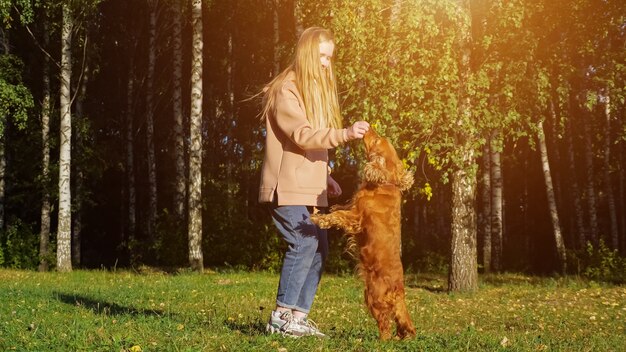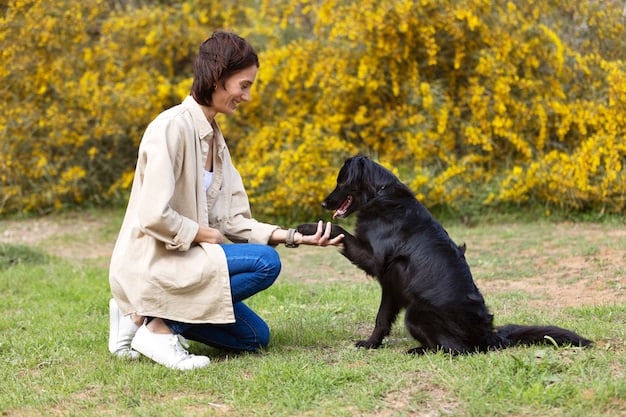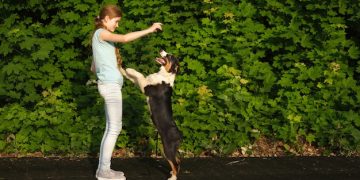Recall Training Mastery: Get Your Dog to Come Back Every Time

Recall training mastery ensures your dog returns to you reliably, even off-leash, by building a strong positive association with coming back through consistent commands, rewards, and creating a fun and engaging training environment that reinforces the behavior.
Achieving reliable recall is a cornerstone of responsible dog ownership, granting your furry friend the freedom to explore off-leash while ensuring their safety. Recall Training Mastery: Get Your Dog to Come Back Every Time (Even Off-Leash) is not just a command; it’s a lifeline.
Why is Recall Training So Important?
Recall training is arguably the most crucial command you can teach your dog. It’s more than just a parlor trick; it’s a safety net that can protect your dog from potential dangers in various environments.
A reliable recall ensures that you can call your dog back from traffic, prevent them from approaching potentially harmful situations, or simply regain control in crowded areas. It builds trust and strengthens the bond between you and your canine companion.
Safety First
Imagine your dog spotting a squirrel and darting into the street. A solid recall can stop them in their tracks, preventing a potential accident. This command can truly be a lifesaver.
Freedom and Independence
With a reliable recall, you can allow your dog more freedom to explore during walks or visits to the park. Knowing they will come back when called provides peace of mind and enhances their quality of life.
- Prevents dangerous situations like running into traffic.
- Allows for off-leash fun in safe, controlled environments.
- Strengthens the bond between you and your dog.
- Provides peace of mind knowing you can always regain control.
Ultimately, mastering recall is about ensuring your dog’s well-being and fostering a harmonious relationship built on trust and clear communication. It’s an investment in their safety and happiness.

Essential Tools and Techniques for Recall Training
Effective recall training relies on a combination of the right tools, positive reinforcement, and consistent techniques. Choosing the right approach can significantly impact your dog’s learning and responsiveness.
From selecting high-value treats to understanding the nuances of positive reinforcement, each element plays a vital role in building a reliable recall response. Let’s explore some essential tools and techniques.
High-Value Treats
Treats are your primary motivator during recall training. Opt for treats that your dog finds irresistible – small pieces of cooked chicken, cheese, or specialized dog training treats often work well. Keep these treats reserved solely for recall training to maintain their appeal.
Positive Reinforcement
Positive reinforcement involves rewarding your dog immediately when they respond correctly to the recall command. This creates a positive association with coming back to you, making them more likely to repeat the behavior.
The Power of Body Language
Your body language can influence your dog’s response. Crouch down, spread your arms, and use an enthusiastic tone of voice to encourage them to come to you. Avoid standing tall or using a stern voice, as this can be intimidating.
- Use high-value treats that your dog loves.
- Employ positive reinforcement to create positive associations.
- Use an upbeat and encouraging tone of voice.
- Incorporate body language to make yourself inviting.
By integrating these essential tools and techniques, you can create a rewarding and effective recall training experience that sets the foundation for reliable off-leash control. Consistency and patience are key to success.
Building a Strong Foundation with Basic Commands
Before diving into recall training, it’s crucial to ensure your dog has a solid understanding of basic obedience commands. These commands serve as building blocks for more complex training, including recall.
Mastery of commands like “sit,” “stay,” and “leave it” not only enhances your dog’s overall obedience but also improves their focus and responsiveness. These foundational skills make recall training more effective and efficient.

“Sit” and “Stay”
These commands help establish control and focus. Practice having your dog sit and stay for increasing durations, gradually adding distractions. This teaches them to listen and obey even in stimulating environments.
“Leave It”
This command is invaluable for preventing your dog from picking up or ingesting dangerous items. Teach them to leave items on the ground when instructed, reinforcing the behavior with a reward.
Consistency is Key
Regular practice of these basic commands strengthens your dog’s understanding and responsiveness. Aim for short, frequent training sessions to keep them engaged and motivated.
- Start with short, focused training sessions.
- Gradually increase the duration and distractions.
- Use positive reinforcement to reward correct responses.
- Be consistent with your commands and expectations.
By establishing a strong foundation with basic obedience commands, you’ll prepare your dog for more advanced training, including recall. This approach ensures they are attentive, responsive, and ready to learn.
Step-by-Step Guide to Mastering the Recall Command
Teaching your dog to reliably come back when called requires a methodical approach. This step-by-step guide breaks down the training process into manageable stages, ensuring both you and your dog experience success.
Starting with controlled environments and gradually increasing the level of distraction, you’ll build a strong association between the recall command and the positive reinforcement that follows.
Step 1: Start Indoors
Begin your recall training in a quiet, distraction-free environment like your living room. Use a clear and enthusiastic command like “Come!” and reward your dog immediately when they come to you.
Step 2: Add Distance
Once your dog reliably comes to you indoors, gradually increase the distance. Call them from different rooms in the house, continuing to use the “Come!” command and rewarding them with high-value treats.
Step 3: Introduce Outdoor Training
Move your training to a securely fenced area or a quiet park. Use a long leash to maintain control and practice the recall command. Gradually increase the length of the leash as your dog’s response becomes more reliable.
Step 4: Off-Leash Training
When you’re confident in your dog’s recall response on the long leash, you can begin off-leash training in a safe, enclosed area. Continue to use the “Come!” command and reward them enthusiastically when they return.
- Start in a quiet, indoor environment.
- Progress to outdoor training with a long leash.
- Gradually introduce off-leash training in safe areas.
- Always use positive reinforcement to reward success.
Following this step-by-step guide will help you methodically build a reliable recall command, ensuring your dog comes back to you every time, even in more challenging environments.
Troubleshooting Common Recall Problems
Even with consistent training, you may encounter some challenges along the way. Understanding common recall problems and how to address them is crucial for achieving long-term success.
From distractions to inconsistent commands, there are several factors that can hinder your dog’s recall response. By identifying and addressing these issues, you can fine-tune your training and ensure a reliable recall.
Distractions
One of the biggest challenges is dealing with distractions like other dogs, squirrels, or interesting scents. Practice recall in increasingly distracting environments to help your dog focus on you.
Inconsistent Commands
Using different commands or changing your tone of voice can confuse your dog. Stick to a consistent command and delivery to ensure clear communication.
Past Negative Experiences
If your dog has had negative experiences associated with coming back to you (like being put on a leash after enjoying off-leash freedom), they may be hesitant to respond. Make recall consistently positive to counteract this.
- Practice recall in distracting environments.
- Maintain consistent commands and tone.
- Ensure recall is always a positive experience.
- Revisit basic training if needed.
By identifying and addressing these common recall problems, you can overcome hurdles and achieve a reliable recall response. Patience and persistence are key to success.
Maintaining and Strengthening the Recall Command Over Time
Recall training is an ongoing process, not a one-time event. To ensure your dog maintains a reliable recall, it’s essential to incorporate regular practice and reinforcement into your routine.
Periodic refreshers, coupled with continued positive reinforcement, will keep the recall command fresh in your dog’s mind and reinforce the positive association with coming back to you.
Regular Practice
Even after your dog has mastered the recall command, continue to practice it regularly in various environments. This will help reinforce their understanding and responsiveness.
Variable Rewards
Keep the rewards varied to maintain your dog’s interest. Instead of always using treats, sometimes offer praise, a favorite toy, or a brief play session as a reward for coming back.
Real-Life Scenarios
Incorporate recall into real-life scenarios, such as during walks or playtime in the park. This will help your dog generalize the command and respond reliably in different situations.
- Continue practicing recall regularly.
- Vary the rewards to maintain interest.
- Incorporate recall into everyday activities.
- Stay consistent with your commands and reinforcement.
By maintaining and strengthening the recall command over time, you can ensure your dog remains responsive and safe, even in challenging environments. Consistency and positive reinforcement are your allies.
| Key Point | Brief Description |
|---|---|
| 🐾 Start Indoors | Begin recall training in a quiet, distraction-free environment. |
| 🌳 Add Distance | Gradually increase the distance as your dog becomes more reliable. |
| 🏞️ Outdoor Training | Practice in a fenced area with a long leash to maintain control. |
| 🦴 Positive Reinforcement | Reward with high-value treats and praise to create positive associations. |
▼
Recall training teaches your dog to come back to you when called, even in distracting environments. It’s essential for their safety, allowing off-leash freedom while preventing dangerous situations and strengthening your bond.
▼
Essential tools include high-value treats your dog loves, a long leash for initial outdoor training, and a positive, encouraging tone. Consistency and patience are also key to successful training.
▼
Begin in a quiet indoor setting, using a clear command like “Come!” and rewarding your dog immediately when they approach. Gradually increase distance and distractions as they improve.
▼
Avoid punishing your dog for not coming. Instead, reassess your training method, reduce distractions, and ensure coming back is always a positive experience. Use a long leash for control if needed.
▼
Practice recall training regularly, even after your dog has mastered the command. Short, frequent sessions are more effective than long, infrequent ones. Incorporate it into daily walks and playtime.
Conclusion
Mastering the recall command is a rewarding journey that enhances your dog’s freedom and safety while strengthening your bond. By using positive reinforcement, consistent training, and addressing common challenges, you can achieve reliable recall, ensuring your dog comes back to you every time, even off-leash.





